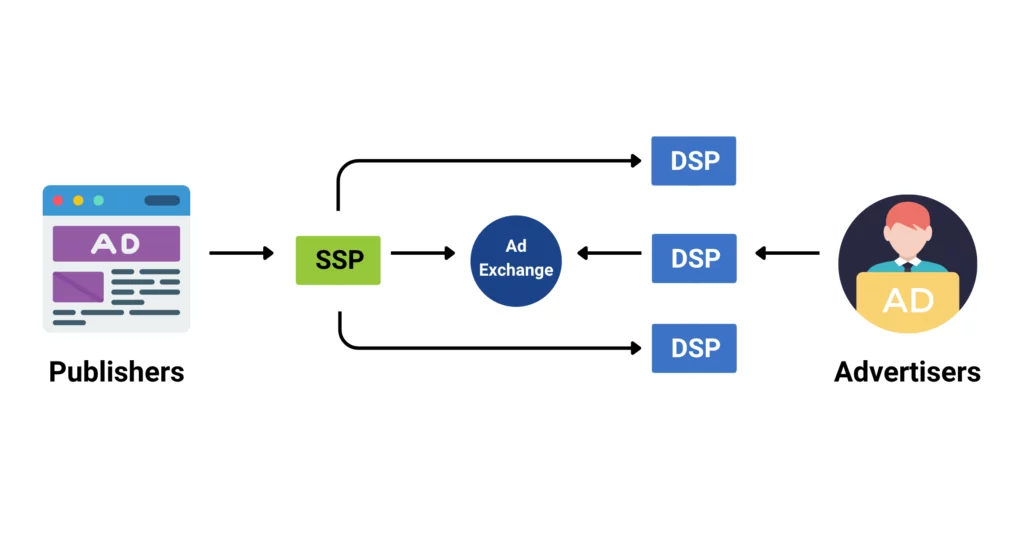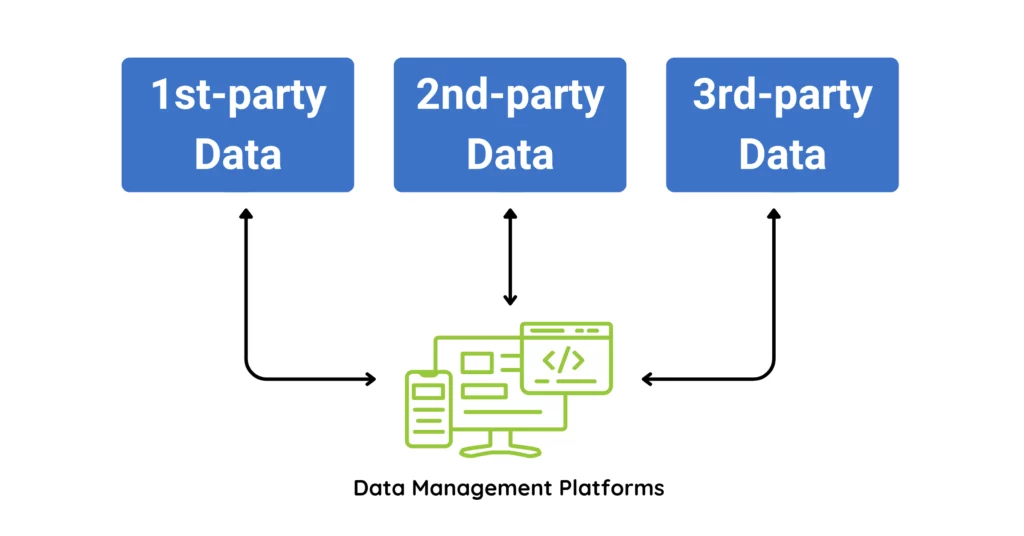Programmatic advertising has come a very long way since its beginnings. What started off as a simple banner ad on Hotwired.com in 1994 has transformed into a complex, data-driven ecosystem that automates the buying and selling of ad space in real-time.
This evolution has revolutionized digital marketing, offering efficiency and additional monetization opportunities with developments such as Header Bidding. An important piece of this puzzle is the collaboration between an SSP and DSP. These platforms play distinct but complementary functions within the ecosystem, and contribute to an overall more profitable advertising process.
For publishers aiming to maximize their revenue and expand their reach, an understanding of what DSP and SSP do is invaluable. In this article, we’ll look into the contributions of these platforms in the ad buying process, their main features, and explain how DMPs work in tandem with them.
What Is a Supply Side Platform (SSP)?
A Supply-Side Platform (SSP) is a technology platform that permits publishers to make their advertising inventory available to programmatic demand. It’s a type of software that brings together ad inventory, multiple ad networks, DSPs, and ad exchanges simultaneously!
Here’s an overview of the role SSPs have during RTB:
- A publisher offers its ad inventory through an SSP.
- When a user visits a publisher’s webpage, an ad request is sent to various ad exchanges and sometimes directly to demand-side platforms. This ad request happens either directly from the webpage to an SSP or from the publisher’s ad server to an SSP.
- Multiple DSPs place bids on the offered impression. The SSP evaluates all the bids and selects the highest one.
- Once the winning bid is determined, the SSP delivers the chosen ad to the publisher’s webpage, displaying the winning advertiser’s ad to the user.
Benefits of SSPs
- Competition: Ultimately, publishers aim to sell all their advertising inventory at the highest possible price, and a quality SSP helps achieve this by connecting them to a wide range of buyers, increasing competition and driving up prices.
- Granular Reporting: A good SSP offers detailed reporting, helping publishers assess value and identify what’s working and what isn’t. Real-time, accurate reports empower publishers to make data-driven decisions and optimize yield.
- Simple and Transparent: The programmatic landscape can be complex, so a quality SSP will offer an intuitive user interface that’s easy to integrate with publishers’ ad stack.
- Ad Quality Control: Another benefit of a quality SSP is that it works actively to prevent poor-quality ads from appearing on a publisher’s site. It also provides control over which advertisers are allowed to bid on their inventory, ensuring their website only shows relevant and high-quality ads.
At Opti Digital, we strategically partner with top-tier SSPs to ensure optimal performance of our publishers’ advertising inventory. Our Opti Engage guarantees higher bid prices and increased fill rates by pooling demand from exclusive partnerships with brands, agencies, DSPs, and SSPs. Our approach enriches existing demand sources rather than replacing them, allowing publishers to continue collaborating with their current SSPs and DSPs while benefiting from the added value of our own demand source. This enables us to complement their existing setup and improve their performance.

What is a Demand-Side Platform (DSP)?
Like stated before, the collaboration between an SSP and DSP is an important aspect of programmatic advertising. SSPs help publishers sell their inventory, on the flip side, a Demand-Side Platform (DSP) is a platform that helps advertisers purchase ad space on an impression-by-impression basis. DSP advertising refers to the use of a DSP. This purchase is done through connections with SSPs and ad exchanges.
Here is an overview of the process:
- Advertisers submit the creative ads they want to share as well as information about their chosen target audience on the DSP.
- As reviewed before, an ad request is created when a user enters a publisher’s webpage
- The SSP offers the ad impression to the DSP, which determines whether to place a bid for the impression based on how well it aligns with the inputted targeting criteria.
- Many advertisers compete with one another by placing bids in real-time.
- The winning DSP buys the impression and the winning advertiser’s ad is shown on the publisher’s website.
Types of DSPs
There are two main types of DSPs used in DSP advertising: self-serve and full-service.
- Self-serve DSPs: A self-serve DSP is a platform that allows advertisers to manage their own ad purchases. The advertiser has full control over the process.
- Full-service DSPs: In contrast, a full-service DSP operates more like an agency, offering support through dedicated account managers. With this option, an external team manages the entire ad campaign.
Benefits of DSPs
There are many benefits to DSP advertising, some of them include:
- Efficiency: By automating the buying process and applying strategic filters, DSPs significantly reduce both operational costs and time spent on ad buying.
- Streamlined Operations: DSPs consolidate ad buying into a single interface, letting advertisers launch campaigns with just a few clicks. This unified approach eliminates the days of juggling multiple vendors and endless email chains.
- Precision Targeting: Another advantage of DSP advertising is its precision targeting, allowing advertisers to build custom audience segments for more nuanced and effective advertising strategies. This is a direct contrast to traditional ad networks, which box publishers into predefined audience segments.
- Data-Driven Decision Making: Modern DSPs provide real-time performance insights in their dashboards, which help marketers quickly identify what’s working and make immediate adjustments to improve campaign performance. c
- Enhanced Campaign Control: From setting specific delivery times to blacklisting unwanted placements – DSPs give advertisers a lot of control.
Do SSPs and SSPs work together?
As you can see, an SSP and DSP do work together to automatize the ad buying process. However, there are key differences:
- SSPs allow publishers to sell their ad space, while DSP advertising lets advertisers purchase ad space and optimize their campaigns.
- SSPs focus on maximizing revenue for publishers, while DSPs focus on achieving better campaign results for advertisers.
- SSPs organize auctions, while DSPs place bids in these auctions.
What is a Data Management Platform (DMP)
An SSP and DSP focus on the efficient buying and selling of ad space. But in the process, DMPs also play an crucial role! Data management platforms (DMP) collect and organize huge amounts of information regarding users, which helps refine ad targeting, perform advanced analytics, and even create models to predict future audience behavior.
The information they collect can come in the form of first-party, second-party, or third-party data.
- First-party data is the most valuable, as it comes directly from users. This includes data from website interactions, mobile apps, CRM systems, and transactional records.
- Second-party data is a user’s first-party data, shared through a partnership agreement. For instance, a website that sells eco-friendly products (call it Green Goods) might collaborate with a website that offers sustainability tips (call it Eco Life). When a user visits Green Goods, a cookie is placed. This cookie is then shared with Eco Life, allowing them to target personalized ads to the user based on their browsing activity.
- Third-party data is collected from external sources, like data brokers or platforms, and is typically used for broader audience targeting. It offers valuable insights based on a wider pool of users, but it often raises privacy concerns.

A DMP follows several key steps to process data for advertisers and publishers, these are:
- Data is collected from various sources.
- The data is standardized through a process called data normalization. This involves organizing IDs from cookies, removing unnecessary information, and adapting the data to the DMP’s format
- Additional information is added to enrich the data. This can include details such as device type, location, browser version, and OS.
- The data is then segmented based on shared attributes. This segmentation helps organize the data into taxonomies or hierarchies, making it easier to target specific user groups, such as those based on location or device type.
- The DMP merges profiles containing identical identifiers, like email addresses or cookie IDs, into a single profile. This eliminates duplicates, making sure each user is accurately represented in the system.
- Once profiles are consolidated, the DMP creates audience segments. These are groups of users with similar attributes, which can then be used for more precise targeting. For example, an audience might be created for “Android users in the USA” based on their shared characteristics
Though DMPs are often attributed to advertisers and agencies, they also offer benefits to publishers. By integrating a DMP with their SSP, publishers are able to better understand user behavior and preferences, which can increase the value of their inventory as well as enhance the user experience.
Conclusion
In conclusion, Supply-Side Platforms and Demand-Side Platforms (SSPs and DSPs) are essential components of the programmatic advertising ecosystem. SSPs help publishers get the maximum revenue from their ad inventory, while DSPs enable advertisers to optimize their campaigns. Data Management Platforms (DMPs) further enhance these operations by providing valuable user insights.
Together, these platforms ensure that the programmatic advertising ecosystem operates smoothly and is profitable for all parties involved.
Make sure to reach out to us if you are interested in our Demand Hub technology, which pools demand from exclusive partnerships with top-tier brands, agencies, DSPs, and SSPs to increase bid prices and fill rates. By complementing your existing setup, Demand Hub aggregates multiple ad formats into a single impression, driving higher CPMs and improving the competitiveness of inventory sales, all while enhancing the user experience with creative ad formats. Make sure to get in touch with us if you would like to unlock the full potential of your programmatic advertising strategy!






